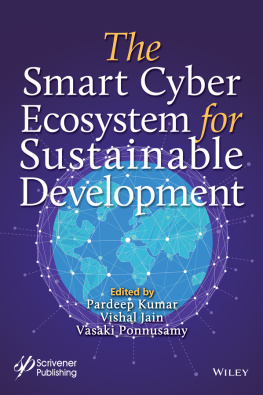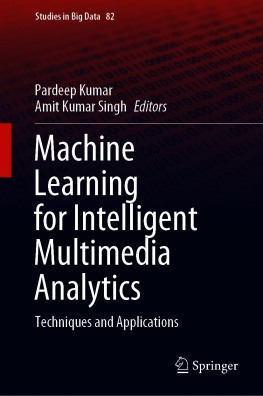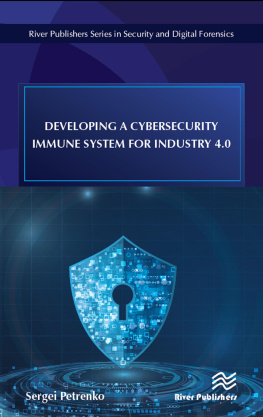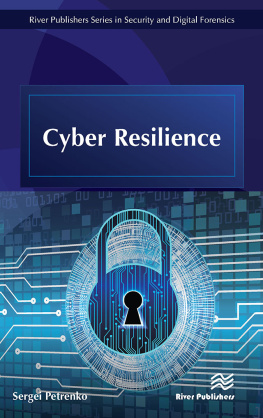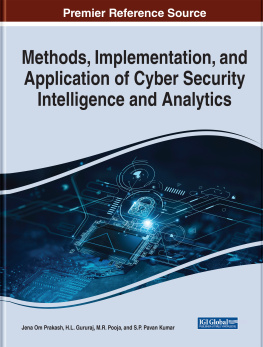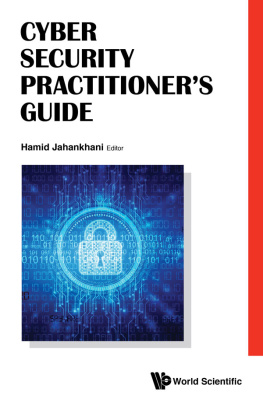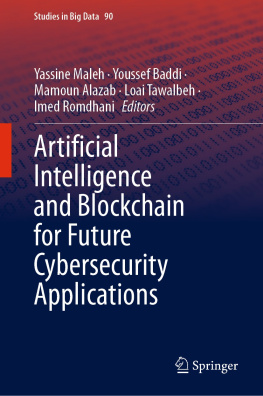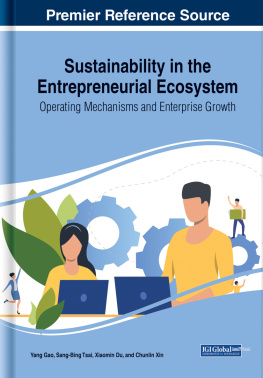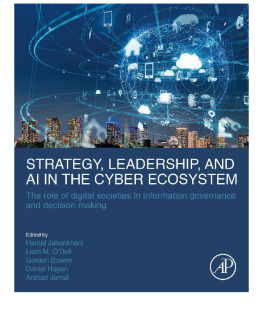
Scrivener Publishing
100 Cummings Center, Suite 541J
Beverly, MA 01915-6106
Publishers at Scrivener
Martin Scrivener ()
Phillip Carmical ()
The Smart Cyber Ecosystem for Sustainable Development
Edited by
Pardeep Kumar
Vishal Jain
Vasaki Ponnusamy
This edition first published 2021 by John Wiley & Sons, Inc., 111 River Street, Hoboken, NJ 07030, USA and Scrivener Publishing LLC, 100 Cummings Center, Suite 541J, Beverly, MA 01915, USA
2021 Scrivener Publishing LLC
For more information about Scrivener publications please visit www.scrivenerpublishing.com.
All rights reserved. No part of this publication may be reproduced, stored in a retrieval system, or transmitted, in any form or by any means, electronic, mechanical, photocopying, recording, or otherwise, except as permitted by law. Advice on how to obtain permission to reuse material from this title is available at http://www.wiley.com/go/permissions.
Wiley Global Headquarters
111 River Street, Hoboken, NJ 07030, USA
For details of our global editorial offices, customer services, and more information about Wiley products visit us at www.wiley.com.
Limit of Liability/Disclaimer of Warranty
While the publisher and authors have used their best efforts in preparing this work, they make no representations or warranties with respect to the accuracy or completeness of the contents of this work and specifically disclaim all warranties, including without limitation any implied warranties of merchant-ability or fitness for a particular purpose. No warranty may be created or extended by sales representatives, written sales materials, or promotional statements for this work. The fact that an organization, website, or product is referred to in this work as a citation and/or potential source of further information does not mean that the publisher and authors endorse the information or services the organization, website, or product may provide or recommendations it may make. This work is sold with the understanding that the publisher is not engaged in rendering professional services. The advice and strategies contained herein may not be suitable for your situation. You should consult with a specialist where appropriate. Neither the publisher nor authors shall be liable for any loss of profit or any other commercial damages, including but not limited to special, incidental, consequential, or other damages. Further, readers should be aware that websites listed in this work may have changed or disappeared between when this work was written and when it is read.
Library of Congress Cataloging-in-Publication Data
ISBN 978-1-119-76164-8
Cover image: Pixabay.Com
Cover design by Russell Richardson
Set in size of 11pt and Minion Pro by Manila Typesetting Company, Makati, Philippines
Printed in the USA
10 9 8 7 6 5 4 3 2 1
Preface
The cyber ecosystem consists of a huge number of different entities that work and interact with each other in a highly diversified manner. In this era, when the world is surrounded by many unseen challenges and when its population is increasing and resources are decreasing, scientists, researchers, academicians, industrialists, government agencies and other stakeholders are looking forward to smart and intelligent cyber systems that can guarantee sustainable development for a better and healthier ecosystem. The main actors of this cyber ecosystem include the Internet of Things (IoT), artificial intelligence (AI), and the mechanisms providing cybersecurity.
This book attempts to collect and publish innovative ideas, emerging trends, implementation experiences, and pertinent use cases for the purpose of serving mankind and societies with sustainable societal development. As outlined in the Table of Contents, the 22 chapters of the book are divided into three parts: Part I deals with the Internet of Things, Part II focuses on artificial intelligence and especially its applications in healthcare, whereas Part III investigates the different cybersecurity mechanisms.
In conclusion, we would like to express our great appreciation to all of those with whom we had the pleasure of working with during this project. First, the editors would like to express their deep and sincere gratitude to all the authors who shared their ideas, expertise, and experience and submitted their chapters in a timely manner. Next, the editors wish to acknowledge the extraordinary contributions of the reviewers for their valuable and constructive recommendations that improved the quality, coherence, and content presentation of the chapters. Finally, our heartfelt gratitude goes to our family members and friends for their love, prayers, and concern, allowing us to complete this project on time.
Dr. Pardeep Kumar
Dr. Vishal Jain
Dr. Vasaki Ponnusamy
July 2021
Part 1
INTERNET OF THINGS
Voyage of Internet of Things in the Ocean of Technology
Tejaskumar R. Ghadiyaliand Manish M. Kayasth1
Udhna Citizen Commerce College & SPB College of Business Administration & SDHG College of BCA & IT, Surat, Gujarat, India
Smt. Tanuben and Dr. Manubhai Trivedi College of Information Science, Surat, Gujarat, India
Abstract
In this technological era, the voyage of the Internet of Things (IoT) in the ocean of technology is very interesting, innovative, and beneficial to society. In this voyage, we have to deal with many icebergs in the form of technology such as Machine-to-Machine Communications, Cloud Computing, Machine Learning, Big Data, Distributed Systems, Smart Device, and Security. Blending of such technology with the IoT ultimately promises not only intelligent systems talking to each other but also with human beings in real time in varied domains such as Healthcare, Agriculture, Transport, Corporation services, Manufacturing, and other Smarter domains. In this chapter, during the voyage of IoT, we will elaborate Introduction (Basics of IoT, Characteristics, Base Architecture of IoT, and Merits and Demerits), Technological Evolution Toward IoT, Associate Technology in IoT, Interoperability in IoT, Introduction to Programming technology associated with IoT and IoT applications, and A special case study with Smart Farming: A paradigm shift toward sustainable agriculture which concludes the chapter.
Keywords: IoT, Internet of Things, Associate Technology with IoT, Interoperability in IoT, Programming in IoT, IoT application, IoT in Agriculture, Smart Farming
1.1 Introduction
There are several motivated factors that tell us why the voyage of IoT is important in the ocean of technology. Current internet service basically provides a connection of computers and computing devices, whereas the Internet of Things (IoT) has expanded its scope from computers and computing devices to other things around us. IoT interconnects physical objects around us such as at home it can be communicated with lights, fans, air conditioners, refrigerators, microwave ovens, and other Bluetooth-operated devices, and at the workplace, it can be communicated with internet operated machines. In the recent era, such Things connected to the internet have crossed over twenty billion. Such things using embedded electronics are going to connect other things around them depending on the application requirements and thus construct a much bigger Inter-network of Things than that of the current internet of computers and computing devices called the Internet of Things (IoT). To do so, IoT devices have to deal with a challenge of interoperability, that means how such different objects can perform inter-communication with each other. So, this is the integral visualization of the IoT.
Next page
